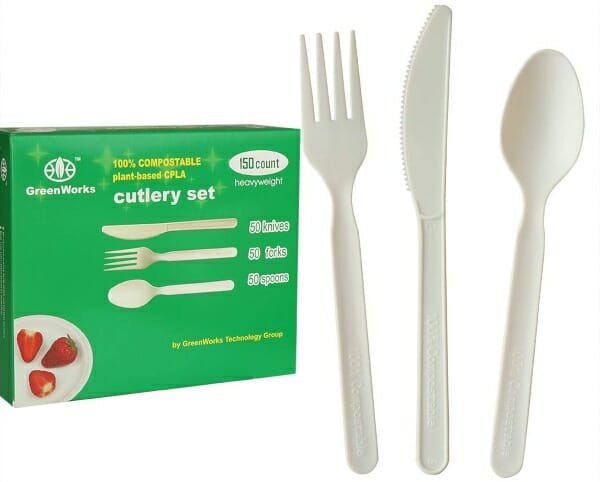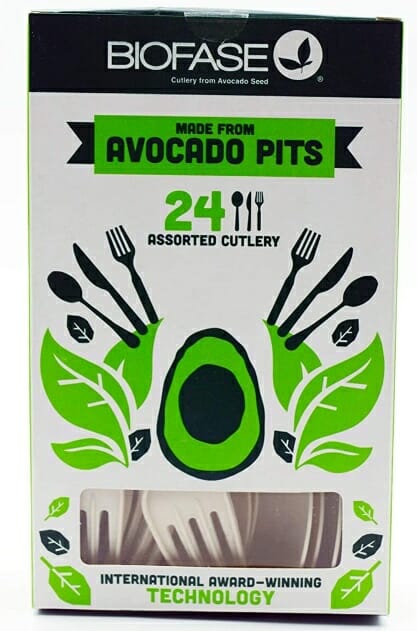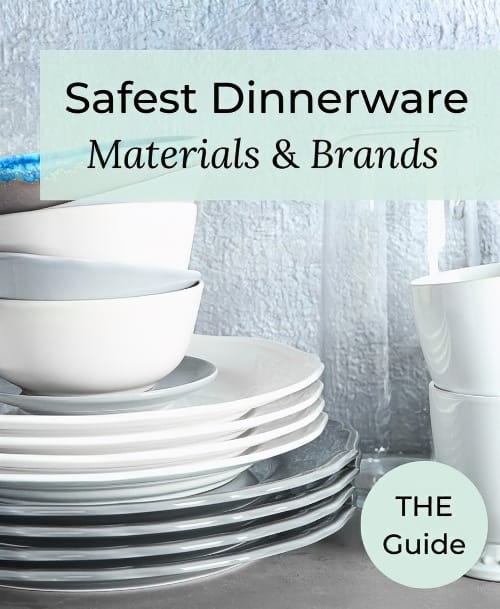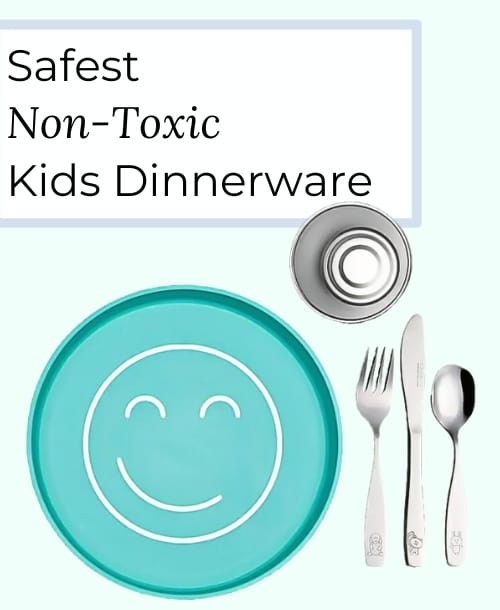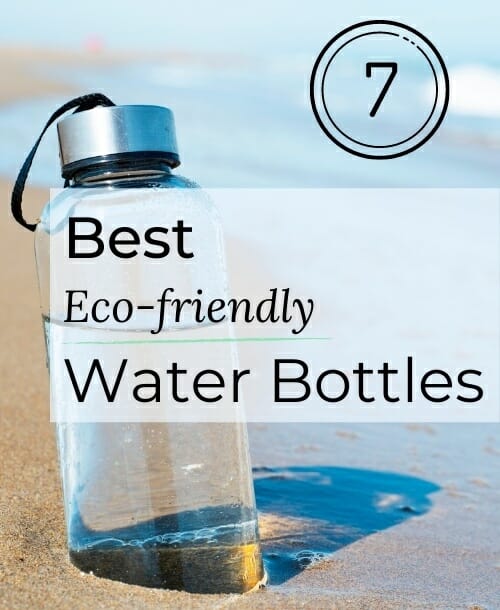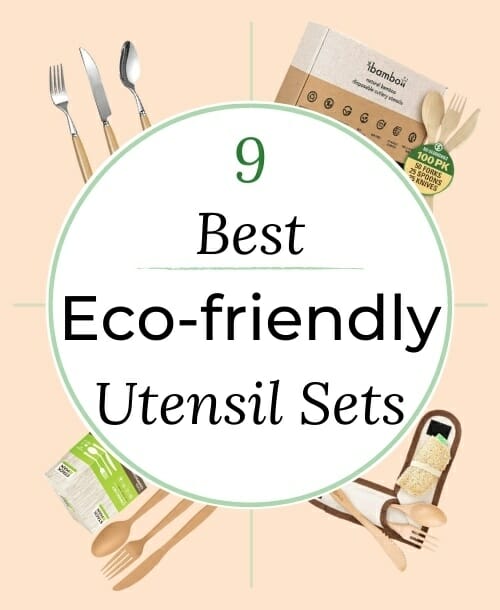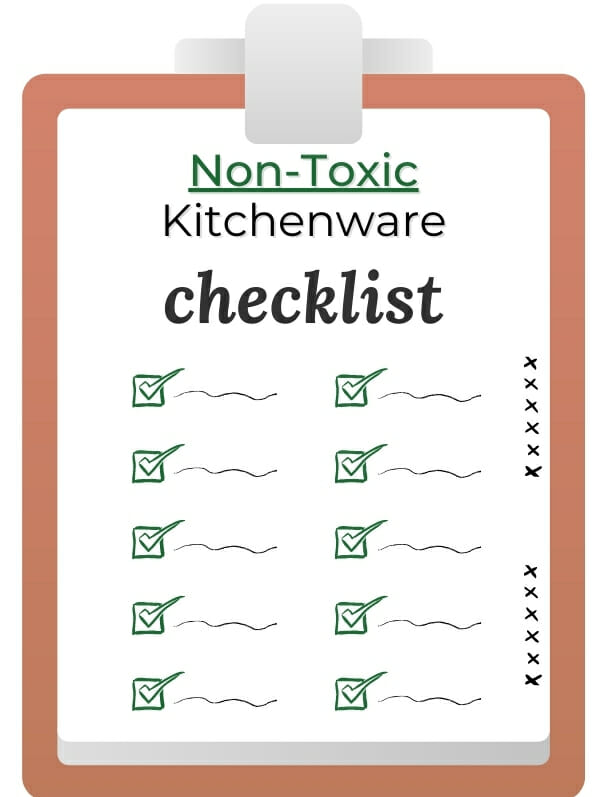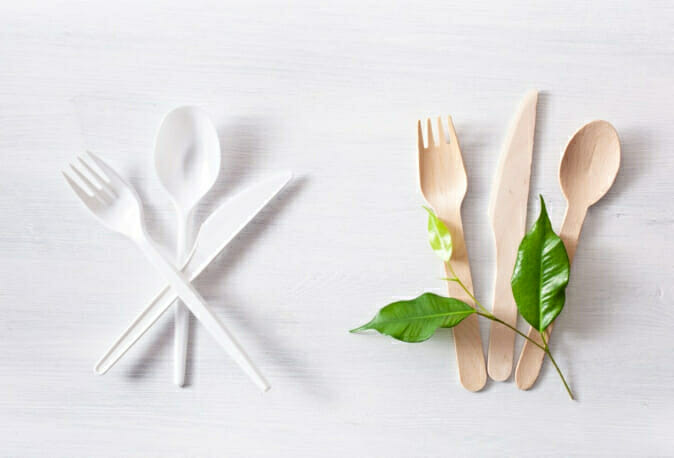
Single-use plastic cutlery terrorizes the planet for 1000 years before breaking down. How important are biodegradable utensils?
Consider this…
Plastic builds up in landfills much faster than it can degrade.
From there, microplastics dissolve into the groundwater and air, ultimately ending up in your body.
Thankfully, compostable utensils can help cut down on the 40 billion plastic utensils discarded each year in the US.
Sounds fabulous, but…
- What are biodegradable utensils made from?
- What’s the difference between biodegradable and compostable cutlery?
- Are compostable utensils really compostable?
- And last, what are the best biodegradable cutlery options out there? Considering many are no better than plastic.
You’ll find those answers and more below, so let’s jump in!
Health & Environmental Risks of Disposable Plastic Cutlery

Think about those 40 billion plastic utensils thrown away in the US.
You use cutlery for what? Ten minutes?
And then boom!
You toss your fork into the trash, and it sits in a landfill (best case scenario) for 1000 years.
During that time, plastic chemicals leach into the air, water, even the foods you eat.
In fact, the average American consumes more than 74,000 microplastic pieces every year. Even more shocking – a credit card-sized amount of plastic (5 grams) per week.
Furthermore, over 1,000,000 marine animals die each year at the hand of plastic debris.
Plastic wastes a ton of money too.
In 2010 alone, manufacturers used 191 million petroleum barrels to make plastic goods.
This is a non-renewable resource.
We’re running out of oil, burying ourselves alive in plastic, and wreaking havoc on wildlife…
All for a little convenience.
So, is bio-based cutlery our saving grace?
It depends on how and where you dispose of your utensil. More on that soon.
What are Biodegradable Utensils Made Of?
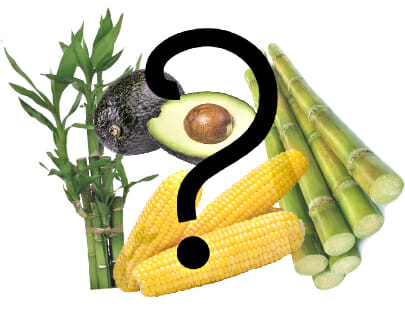
Bio-based cutlery stems from corn or sugarcane, plant oils, animal fats, straw, woodchips, orange peels, or even sawdust.
From there, producers turn these natural materials into PLA (Polylactide Acid), a bioplastic.
PLA resembles traditional plastic, but it’s renewable and vegetable (bio)-based.
But keep an eye out for…
“Shady” Bio-plastics
Other forms of biodegradable plastic exist besides PLA, called “oxo-degradable.”
Like regular plastic, these come from petrochemicals.
But, chemical additives help speed up the breakdown process.
Here’s the problem…
As they degrade, petro-plastics leave behind toxic residue and small shards of material.
Wildlife confuses those shards for food.
See the problem?
So, choose bio-based plastics when hunting for healthier options (like every option on this page).
What is the Difference Between Biodegradable Silverware and Compostable Cutlery?
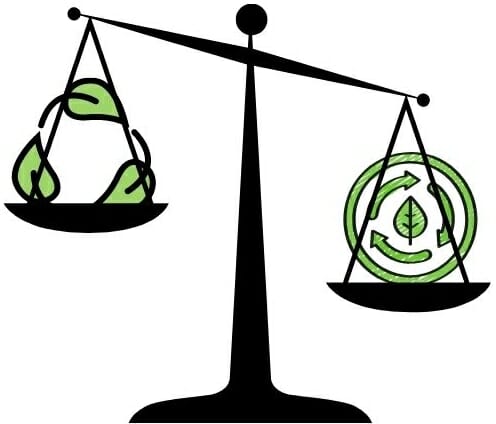
There is a lot of confusion around this topic.
Perhaps you imagine biodegradable and compostable plastic as a black and white difference.
But it’s more of a gray area.
Let’s define each…
Biodegradable Cutlery – Defined

“Biodegradable polymers (BDPs) or biodegradable plastics refer to polymeric materials that are capable of decomposing into carbon dioxide, methane, water, inorganic compounds, or biomass in which the primary mechanism is the enzymatic action of microorganisms.”
Did that hurt your brain too?
Here’s the English translation…
The biodegradable forks, knives, and spoons break down regardless of conditions. The ground’s organisms eat the plastic.
There’s no need for extra resources (like industrial facilities).
But, this type has tradeoffs.
Compostable Utensils – Defined
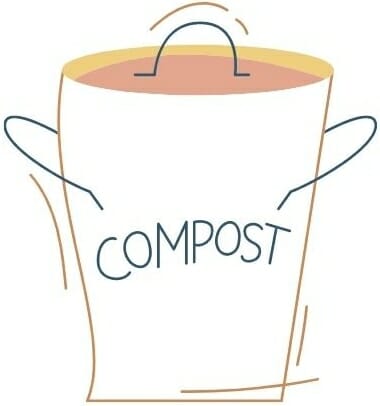
“A subset of BDPs may also be compostable (compostable cutlery) referencing their bio-degradation in an industrial compost facility.”
Huh?
What does compostable in industrial facilities mean?
This means the bio-plastic breaks down under high heat and controlled moisture. This happens at a special facility.
After the breakdown, the plastic shouldn’t be visible. Instead, only carbon dioxide, water, inorganic compounds, and biomass will remain. (ASTM standard D6400).”
Again, in English, the same result as above. But, the process uses a controlled setting to degrade the plastic instead.
So these utensils really are compostable, but only under specific conditions.
That leads to the next point. Here’s what I meant earlier about “tradeoffs.”
Are biodegradable plastics better for the environment?
It depends. If you don’t dispose of biodegradable utensils properly, the plastic won’t fully degrade in the environment. Also, the bioplastic produces methane gas as the material degrades.
Methane is a greenhouse gas with 25 times the effect of C02.
While “landfill gas” can become a power source, The Landfill Directive seeks to reduce biodegradable public waste.
But here’s why bioplastics are the best disposable utensils…
They do not produce a net increase in carbon dioxide when broken down.
The plants used to make the utensil absorb the same amount of carbon dioxide, to begin with.
So, the material is already part of the biological carbon cycle.
The best option
Remember, calling a product biodegradable has no value if the trash does not end up in the proper system.
So, use compostable plastics that can break down in industrial facilities.
They will help generate carbon and nutrient-rich compost for the environment!
Quite the opposite from plastic disposables!
Where are these industrial facilities?
Use this directory of US composting facilities to find a site near you.
If you’re unable to send utensils to a facility, consider bamboo, bagasse, or avocado utensils.
They will break down naturally in the trash (a few options below).
Benefits of Biodegradable Flatware
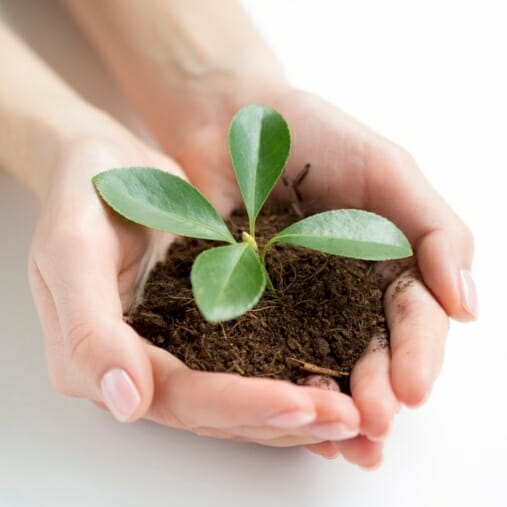
Now that you know the ins and outs of bio-plastics, here are a few benefits of biodegradable utensils.
You will:
- Save countless plastic utensils from cluttering the ecosystem, without sacrificing convenience.
- Help increase air quality without effort.
- Reduce your exposure to toxic chemicals and live healthier.
- Prevent unnecessary wildlife deaths (thanks human).
- Conserve non-renewable resources, which can help lower oil costs.
- Produce nutrient-rich soil to benefit agriculture for better food.
Also, producing biodegradable cutlery requires less energy to produce compared to petro-plastics.
This is because starch production is less resource-heavy than petroleum refinement.
Bioplastic manufacturers use less water, too.
So, compostable cutlery (with proper disposal) benefits your health and the environment!
Now, the last question to answer is, what are the best biodegradable utensils to use?
Below, you’ll discover the six most eco-friendly disposable utensils (100% plastic-free).
Even if there are no industrial facilities in your area, there’s an option suitable for you.
Everything from compostable plasticware to biodegradable avocado cutlery and more. It’s all below.
Best Eco-friendly Disposable Cutlery Picks for Each Bioplastic Type
The eco-friendly disposable flatware picks below meet the criteria above (not petro-based).
And, they’re the highest-rated among customers!
We’ve researched for you 🙂
First, you’ll find cornstarch cutlery in a couple of different sizes and colors.
Biodegradable Corn Utensils
#1
GreenWorks 100% Compostable CPLA Cutlery Set (150-Pack)
This guilt-free set of disposable and biodegradable corn utensils comes from GreenWorks.
Each 150pc set includes biodegradable forks, knives, and spoons (fifty of each).
Greenworks crafts their utensils from non-GMO corn-based polylactic acid (CPLA). So, entirely plastic and weird chemical-free!
Strong, too. In fact, you’ll love how peanut butter-friendly these utensils are. Some may say sturdier than plastic; I’d say they’re about equal.
As a result, they’re the perfect disposable utensil for formal events when you need to leave a good impression – without sacrificing convenience.
Concerned about safety? Don’t be. This eco-friendly disposable silverware is FDA-approved and ASTM-certified for meeting strict quality standards.
Drawbacks: Not backyard compostable, nor will they break down in landfills. You have to send this flatware to an industrial composting facility. For a landfill-degradable option, go with either IBamboo or Avoplast below.
Click here to grab this set of cornstarch utensils from GreenWorks on Amazon.
Are you looking for forks only?
Check out this 50-pack of compostable forks from World Centric – a certified B-Corp with 100% carbon-neutral shipping! Plus, they donate 25% of your proceeds to world-changing non-profits.
Looking for spoons?
#2
GreenWorks Individually-Wrapped Compostable Cutlery Sets (200-Pack)
This set of plant-based, biodegradable flatware is perfect for busy professionals looking to save time.
Instead of tossing a separate fork, knife, spoon, and napkin in your bag, simply grab one of these packs, and head out the door.
That’s right.
This 200-pack includes 200 individually wrapped flatware sets. Each set contains a compostable spoon, fork, and knife, plus a convenient napkin.
And the wrapper? It’s compostable, too! See, you can have guilt-free convenience!
Each utensil measures roughly 7″ long and withstands heat up to 200℉, so it won’t melt into your lunch. Many customers explain how surprisingly sturdy this earth-friendly cutlery is too.
Overall, if you’re looking to cut waste and save time in the process, here’s your set.
Drawbacks: Like Greenworks above, these won’t degrade rapidly in the environment. You’ll have to send them to a composting facility.
Click here to grab this biodegradable utensils bulk set from GreenWorks on Amazon.
Disposable Bamboo Utensils
#3
Ibamboo Natural Disposable Bamboo Utensils Set (100-Pack)
This bamboo disposable cutlery set contains 50 non-plastic forks, 25 spoons, and 25 knives. All measure 6.7″ in length.
The best thing about bamboo compostable cutlery?
It degrades on its own. So if you don’t have any composting facilities nearby, here’s your best option!
Plus, bamboo is way more sustainable than wooden cutlery – it grows like a weed.
And it’s rugged. In fact, many customers explain how these compostable knives easily slice through tough meat. Bamboo makes a sturdy material for kitchen utensils, like cutting boards.
Ibamboo sources its bamboo ethically, too (thank you, Ibamboo).
Sustainable convenience that’s plastic and guilt-free… What’s not to love?
Drawbacks: The only drawback I see is the texture. Not that it’s really rough, but it’s not as smooth as plastic, which may take a bit of adjustment.
Click here to snag this set of biodegradable bamboo utensils on Amazon.
Looking to buy elsewhere? Get this set here on Etsy.
Other options: You can also get 100-packs of each utensil on Amazon, not just a mixed set— 100-pack of forks—100-pack of spoons—100-pack of knives.
Biodegradable Utensils from Avocado Pits
#4
Biofase – Avocado Compostable Mixed Cutlery Set (24-Pack)
Check out these biodegradable utensils made from avocado seeds!
Yup, Avoplast makes this biodegradable cutlery set from Avocado scraps right in Mexico.
The cool thing is, avocado utensils share a similar makeup to the corn cutlery above, so they’re just as durable.
One customer mentioned, “It has a lot more substantial feel to it than plastic.” And another, “They have the look and feel of good plastic wear. and hold up to normal use.”
And once in a compost pile or landfill, your avocado seed utensils degrade in about 240 days.
Click here to grab your mixed cutlery set from Avoplast.
You can buy different cutlery types individually, too. Avoplast has a whole line of biodegradable tableware! See below—
Their avocado pit cutlery line also includes a fork set, spoon set, knife set, and straw set.
Drawbacks: Keep in mind the packs are small and best for a few people. For large parties, you’ll need a few sets.
Click here to visit Avoplast’s storefront on Amazon and check out their avocado pit utensils.
Biodegradable Edible Utensils
Composting is not your only option for being eco-friendly. How about eating your utensil after you’re done!?
Unfortunately, due to difficulties creating shapes, few edible silverware options are available.
But, for the sake of this article, you’ll find (tasty) spoons and straws.
A bit of a letdown, but even spoons and straws alone reduce vast amounts of pollution.
#5
Edible Spoons – Eco-Friendly Cutlery (20-Pack)
These edible and biodegradable spoons are a fun and tasty way to cut down on single-use waste.
The spoons come from wheat, oat, corn, chickpea, and barley with a small amount of sweetness.
incrEDIBLE spoons are non-GMO, vegan, and backyard compostable too.
You can enjoy these eco-friendly utensils with both hot and cold foods. The spoons hold their structure for 30 minutes regardless.
These spoons are unique.
You can use them for desserts and enhance your eating experience. Think ice cream cones! With cereal, you’ll enjoy a pleasant flavor boost.
Choose from chocolate and vanilla flavors, perfect for dessert.
Twenty spoons come per pack, each nestled in a recyclable paper bag.
Drawbacks: The spoons may not soften enough depending on what you eat. They’re pretty hard to eat by themselves.
Click here to grab some edible spoons from incrEDIBLE.
Other options: Check out this pack of incrEDIBLE’s mini spoons.
Looking to buy elsewhere? Explore more edible cutlery here on Etsy!
#6
Ecostraws – Straws from Pasta – Thick Size (24-Pack)
Ever scarf down raw pasta while you heat a pot of water? I know I’m guilty!
Well, what if we can use pasta for more than just eating?
Ecostraws asked the same question… That’s why now they use 100% durum wheat semolina from Italy to craft these eco-friendly (and tasty) drinking straws!
Each straw in this 24-pack measures 10” in length and has the width to accommodate smoothies.
Once in your beverage, the pasta stands firm for over an hour without softening. So no worries about it drooping down into your half-full glass.
When you’re finished, simply compost your pasta straws – just like edible spoons and all other edible cutlery.
Or, toss them right in your trash bin. Marine wildlife can gobble them up without issue, although the pasta will often (safely) break down by then.
In my opinion, they’re the perfect environment-friendly replacement for plastic straws in restaurants and homes.
Drawbacks: The 24-pack is a bit pricey for the quantity. You’re better offer going with the 120-pack or the 1000-pack – see below.
Click here to grab a set of biodegradable straws from Ecostraws.
Other options: Ecostraws offers a jumbo 120-pack, which is much more cost-effective; get it here! Or, grab this massive 1000-pack from PastaStraws. (Best value for dollar overall)
Compostable Plates and Utensils Set (Bagasse Fiber)
#7
Fuyit Disposable Sugarcane Dinnerware Set (250-Pack)
Check out this 250pc set of sugarcane bagasse fiber dinnerware.
Like avocado utensils, here’s an example of reusing the leftovers of food processing.
These plates come from sugarcane’s leftover fibrous pulp after sugar production.
So there’s no extra burden on the environment!
The utensils themselves are cornstarch and need to go into compost.
But the plates are sugarcane and will degrade right in your trash bin!
The set includes 50 compostable plates and 50 forks, knives, and spoons. They are microwave, freezer, hot, and cold food-safe.
Click here to grab a set of sugarcane bagasse plates and utensils.
If you don’t like the natural beige color, Fuyit sells a white-colored set; get it here.
Want fewer pieces? You can find a smaller 172-pack here. Want more than 250 pieces? Here’s a jumbo 350-pack.
Looking to buy elsewhere? Premium Paper Products offers sugarcane bagasse plates and bowls on Etsy, all made in the USA. Plus other paper goods— Check them out here.
Best Eco-friendly Travel Cutlery
Reusable, on-the-go utensil kits are the best option overall for reducing plastic waste…
Now yes, biodegradable cutlery and composting are a better choice than single-use plastic, for sure.
But with reusable utensils, you can avoid plastic, reduce pollution, AND save money over disposables! It’s a no-brainer!
For large parties and events, biodegradable disposable cutlery will be your best and easiest choice.
But if you’re alone, reusing is your best option… Believe me.
And yeah, sure, it’s a little extra work to clean. But if you can imagine the resources saved, it’s worth the saved cash!
These “reusable utensil kits” include everything from forks, spoons, knives, straws, and even chopsticks!
All pieces come held in convenient travel pouches for lower-stress packing, too 😉
So, check the ten best eco-friendly reusable utensil kits out there, right here!… All meant for on-the-go.
Conclusion
So that’s a wrap! First, you discovered how biodegradable utensils are made. Then, the difference between compostable utensils. And finally, the seven most eco-friendly disposables.
Want to go a step further?
Check out this post on toxin-free dinnerware to ditch all the plastic on your table!

Hi there! I'm Adam, author and founder of TGL. Since 2016, I've produced and sold non-toxic kitchenware throughout the US. Today, I'm using my passion and experience in sustainable product manufacturing to help families avoid unsafe reusable foodware. When I'm not writing, you'll find me hiking or camping throughout Appalachia!
Enjoyed this post? Share it with your friends!
Related Posts
FREE Guide
Non-Toxic Kitchenware Checklist
Get a step-by-step product guide with insider tips & tricks for the safest kitchen possible!
Additional Sources:

